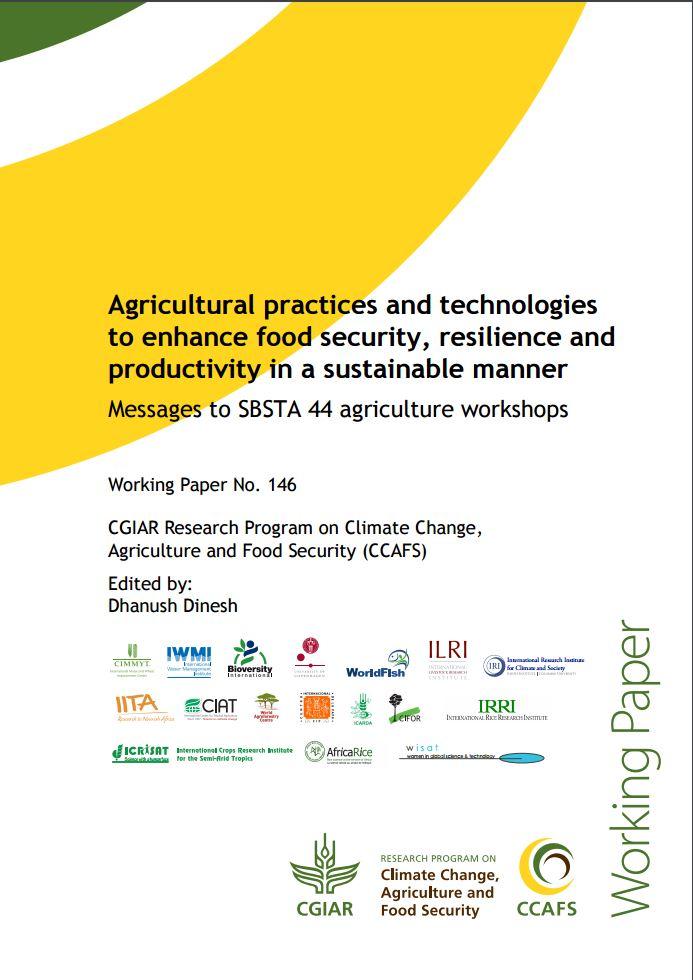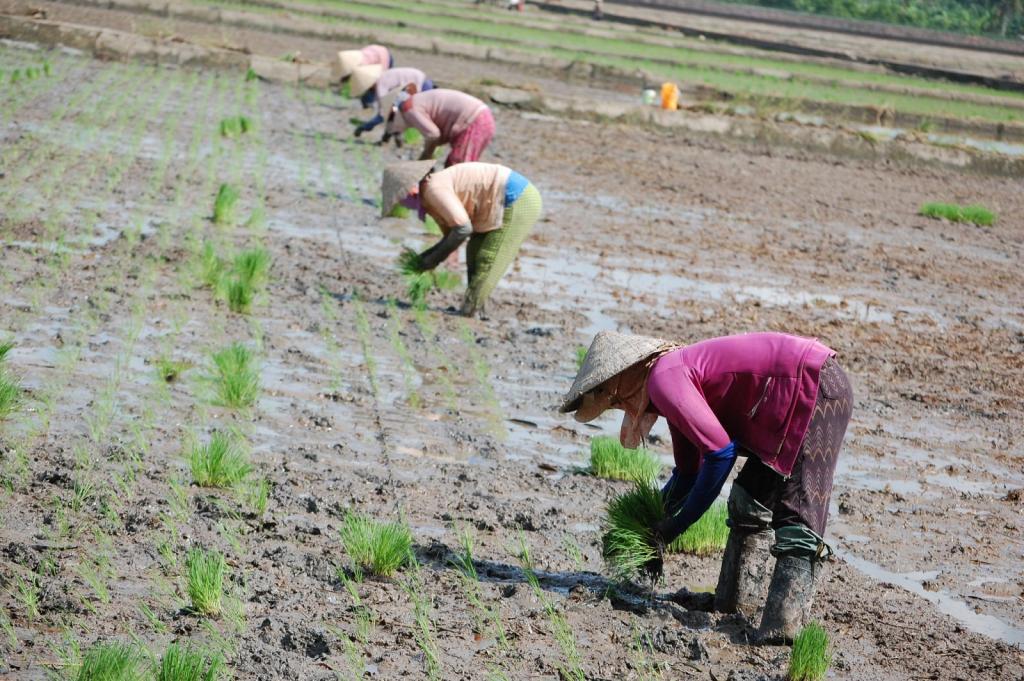Best-bet agricultural practices synthesized ahead of COP22

Working paper brings together CGIAR knowledge on the latest agricultural practices and technologies to sustainably enhance food security, resilience and productivity.
Agriculture stands in a precarious position in relation to climate change: it is affected by, and itself affects, climate change. This complex relationship raises the need to shift agricultural production to simultaneously enhance its resilience to climate impacts and mitigate agriculture’s negative environmental impacts, while ensuring that food security is not compromised along the way.
A wide-range of suitable agricultural practices and technologies are already available to serve this purpose. Governments appreciate the urgency for action on climate change, meaning that much progress has already been made that can be learnt from and expanded upon. Drawing upon the knowledge of CGIAR and partner experts, CCAFS has published a working paper cataloguing the most up-to-date agricultural practices capable of sustainably enhancing productivity and climate resilience.
Answering the call for knowledge to guide COP22

This year, the UNFCCC Subsidiary Body for Scientific and Technical Advice (SBSTA) has put a focus on addressing issues relating to agriculture, inviting parties and observers to present their views. Aiming to bridge the science-policy gap, the working paper provides an accessible knowledge base to inform parties and observers who are making submissions to SBSTA in May, or participating in the following workshops.
The outcomes of the SBSTA 44 agriculture workshops will play a key role in setting the agricultural agenda for COP22 in Marrakesh in November, making the working paper a vital resource for policymakers. Anette Friis, Head of Program Coordination at CCAFS, highlights the lasting importance of this year’s negotiations:
SBSTA 44, and subsequently COP22, presents countries with the opportunity to address the pressing issues related to agriculture, covering the whole spectrum of adaptation, mitigation, finance, capacity building, and technology transfer, taking into account the needs of over 500 million smallholder farmers.
Choosing the right tools for the job
The working paper highlights the most promising practices and technologies across the rural landscape, covering soils, crops, livestock, water, forests, fisheries, energy and services. These are exemplified through a rich catalogue of case studies, these interventions span the diverse agricultural systems within the CGIAR research portfolio. Bruce Campbell, Program Director of CCAFS, explains how putting research into action can benefit farmers:
CCAFS research on agricultural practices and technologies cover a wide range of topics, including soils, crops, livestock, forestry, fisheries, water, energy, as well as climate information services and insurance. These topics converge at the farmer level, helping them make crucial choices which determine their long-term sustainability.
The working paper sheds light on each of these topics, highlighting successful interventions ranging from simple on-farm practices, to services that help boost climate resilience and productivity for millions of farmers. For example, within crop management, intercropping coffee with banana in East Africa provides an opportunity to enhance the resilience of the valuable but highly climate-sensitive coffee, while increasing farmer incomes by over 50%. In terms of water management, the efficient technique of alternate-wetting and drying during rice production allows farmers in Southeast Asia to lower costs by reducing water use by 30%, while reducing methane emissions by up to 48%.

Rice is a key staple for food security in countries such as Vietnam, but flooded rice systems produce over 10% of global agricultural emissions. Alternate wetting and drying is a most promising practice due to its water-use efficiency and potential for mitigation co-benefits. Photo: V. Meadu (CCAFS)
On a larger scale, improved weather-index insurance schemes in India based on CCAFS science can protect farmers from climate-related uncertainty, by offering pay-outs based on highly accurate weather triggers. Technological innovations include laser-assisted precision land levelling (LLL), which has been scaled up to cover 500,000 hectares of land in India, increasing wheat and rice yields, while conserving over 1 billion m3 of water and minimizing CO2 emissions.
One size does not fit all
Building farmers’ capacity to make informed decisions is crucial for ensuring resilience. While the case studies demonstrate ample opportunities for sustainability enhancing agricultural resilience, productivity and food security, one of the most important lessons extracted from the working paper is that not all practices are universally applicable. Due to the high level of diversity across agro-ecological zones and farming systems, it is evident that interventions must be matched to specific contexts. Todd Rosenstock, of the World Agroforestry Centre (ICRAF), explains that “many practices can be suitable somewhere, but none are likely suitable everywhere.”
The best interventions may vary even within the same type of crop; for example, in the West African cocoa belt, some areas will be hit harder than others by climate change, making the use of crop shading only relevant in certain areas. To ensure that interventions can successfully reach scale, mechanisms for developing capacity enhancement and technology transfer between countries and farming communities are key. In some cases, indigenous knowledge can be a fruitful launching point, such as building contour stone bunds to adapt to high intensity rainfall in the West African Sahel.
Money makes the world go round
The availability of finance was a crucial ingredient for success in many of the case studies. The Drought Tolerant Maize for Africa (DTMA) project has the potential to help millions of people across sub-Saharan Africa adapt to drought conditions, and was funded by the Bill and Melinda Gates Foundation. Similarly Uruguay’s 'Building Resilience to Climate Change and Variability in Vulnerable Smallholders' received nearly USD 10 million in financing from the UNFCCC Adaptation Fund, with pilot farms providing evidence of multiple wins for productivity, resilience and sustainability.
High start-up costs often impede smallholders’ adoption of new agricultural practices, even if the long-term benefits outweigh the initial costs. However, the right injection of finance can help overcome this barrier, such as in the previously mentioned case of LLL, where subsidies from the Government of Haranya were crucial for establishing a market for the technology.
Further scaling up best practice will rest upon the availability of suitable funding sources. Fortunately, a great deal of the interventions that can sustainably enhance productivity and resilience are low-cost in nature, making them low hanging fruit for investment.
Related reading
In addition to 'Agricultural practices and technologies to enhance food security, resilience and productivity in a sustainable manner', a complementary working paper has been published focusing on adaptation measures above the farm level. Practices and technologies employed by farmers will need to be implemented in the context of public and private sector adaptation activities, including policy frameworks, adaptation financing, extension services and climate modelling. Together, the two working papers aim to inform upcoming SBSTA sessions and COP negotiations by providing a holistic perspective of the available interventions for enhancing climate adaptation.
Download the papers
- Working paper: Agricultural practices and technologies to enhance food security, resilience and productivity in a sustainable manner: Messages to the SBSTA 44 agriculture workshops
- Info note: Climate change adaptation in agriculture: practices and technologies
- Working paper: Adaptation Measures in Agricultural Systems: Messages to the SBSTA 44 Agriculture Workshops
- Info note: Measures for climate change adaptation in agriculture
Read more: New resource on adaptation measures in agricultural systems for climate negotiators
Snorre Frid-Nielsen is a student assistant at the CCAFS Coordinating Unit, contributing to policy engagement and research.
